| Ghibli Buyer's Guide
"Ghibli II ... the Biturbo finally comes of age!" |
|||
|
|
|||
| ANOTHER GREAT ARTICLE BY ANDY HEYWOOD | |||
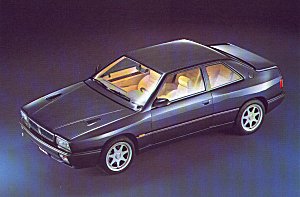 |
I always felt that the Ghibli was the car that the Biturbo should have been all along. In true Maserati tradition, it displayed a muscular, aggressive (yet beautiful) body style which was at the same time restrained, especially in dark colours. Its interior was luxuriously appointed, relying less on the communal parts bin and cheap materials that marred the original Biturbo. |
||
Above all, it had that elusive 'want one' factor. Sadly, its time was cut short by Ferrari occupation of the Maserati factory and subsequently has suffered from the propaganda for the new 3200GT which effectively rewrites history to eliminate the De Tomaso era. |
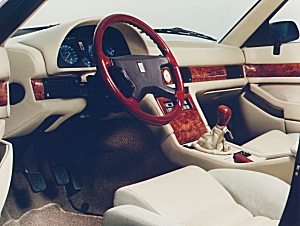 |
||
| EVOLUTION | |||
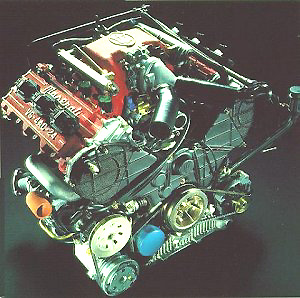 |
The advent of the modern Ghibli streamlined the range of cars that Maserati offered which, up to that point, had been at best confusing. No longer were they offering seven different models at the same time - in the UK alone - but merely two, the convertible Spyder and the two door coupé Ghibli. |
||
Already available in Italy for a year, the first right-hand drive Ghiblis arrived at the then concessionaires, Meridien in Lydhurst, in 1993. For the Italian market the engine for the Ghibli was a two-litre unit, but for the export markets it was the 2.8-litre version. This was the four-valve per cylinder, four camshaft version of the original Biturbo V6. It was an engine with which the Italians were familiar having been available in two-litre form in the 'Racing' since 1990. In the UK, a handful of 222s and 430s had previously been available with the 2.8-litre version known as 222 4V and 430 4V. |
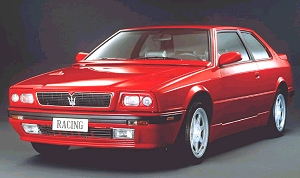 |
||
For Ghibli applications the engine management system was all-new, with direct ignition (i.e. no distributor) and a separate ignition and fuel ECU for each bank of three cylinders. So equipped, the 2.8-Iitre developed 284bhp at 6,00Orpm and 42.1 kgm of torque at 3,50Orpm (306bhp at 6,000rpm and kgm at rpm for the two-litre version). The two turbochargers were still Japanese IHI units, fed through twin intercoolers. |
|||
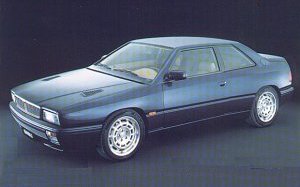 |
The suspension was by MacPherson struts front and rear, and differed from the Biturbo in that the shock absorbers (developed by Koni) were electronically adjustable through four settings on a key pad sited next to the gear lever. The wheels for the first model were 16 inch diameter (a flat seven-spoke design made by both OZ and Mille Miglia) and allowed fitment of larger ventilated discs front and rear than had been possible with the Biturbo. |
||
Equipment levels were high, including air-conditioning as standard with full climate control, electric windows and door mirrors, electric seat recliners and, of course, that trademark clock. Although the style of the interior was similar to the final Biturbos, where there had once been a mixture of leather and Alcantara, now there was full Connolly leather and properly veneered wooden dash and door panel inserts. Overall, and combined with far better build standards, the car exuded a quality, hand built feel. |
|||
While changes to specification on the home market took place for the 1994 model year, it was 1995 before the
addition of Bosch ABS and still larger wheels (17 inch) marked a change in name to Ghibli ABS in the UK. |
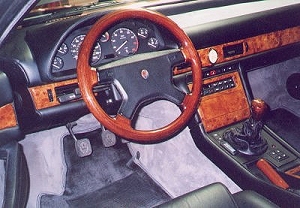 |
||
These changes centred mainly around the adoption of the Quattroporte axle (taken from the Ferrari 456) and tubular rear suspension as fitted on the race cars, and a Getrag six-speed gearbox. |
|||
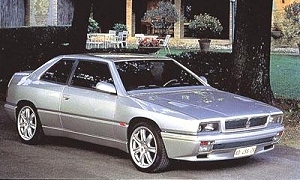 |
Automatic transmission was still an option. There were few external clues to the new specification apart from another change in wheel design, still 17 inch but now with a ribbed spoke design by Milie Miglia. |
||
|
The GT was the final version of the model, the only other version being the Open Cup race replica which was sold alongside the GT from 1996 to 1998. The Cup used all the upgrades of the GT but with a two-litre engine only, even in right- hand drive form. This engine used roller bearing turbos - different from any other model - modified engine management mapping, and a freer-flowing exhaust system which helped it to develop 330bhp. Further changes were made to suspension bushing, and larger Brembo brakes were also fitted. Externally, the Cup was distinguished by its use of five-spoke split rim Speedline wheels and single outlet per side exhaust pipes, as opposed to twin tailpipe per side on all other models. It also had a badge on the lower doors proclaiming it Ghibli Open Cup and a racing style aluminium fuel filler cap. Internally, the differences were greater, the wood being exchanged for carbon-fibre inserts. Drilled pedals, Momo Corse steering wheel and aluminium gearknob completed the racing car ambience. |
|||
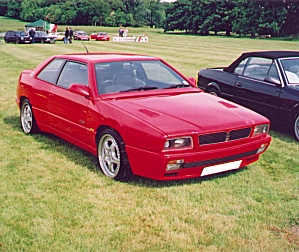 |
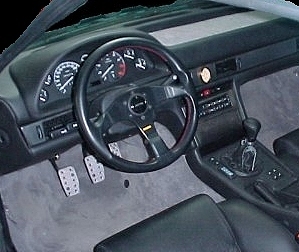 |
||
|
While the Cup was a limited edition, the GT continued until 1998 when the Maserati factory closed for refurbishment and the installation of the 3200GT production line. On re-opening in early 1999, another 250 Ghiblis were made using remaining bodyshells and parts (some of which were destined for the UK) before the 3200GT finally took over and the Ghibii was deleted. |
|||
| SALES AND MARKETING | |||
From 1991 to 1998, Meridien were the sole Maserati concessionaires for the UK. They imported approximately 150 Ghiblis in that time including 26 Cup models. Since then, when Maranello Concessionaires took over, there have been a further 17 of the post factory shut-down cars imported. In addition to this, there have been a number of left-hand drive cars personally imported to take advantage of the strong pound and the seeming lack of interest in the cars on the home market, although these probably only account for 10% of the cars registered in the UK. |
|||
|
The price of a Ghbli in the UK in 1994 was £42,000. This rose to £46,000 for a GT in 1996 and £47,500 for a Cup in 1997. The cars imported by Maranello Concessionaires were soid at varying prices. |
|||
| SERVICING COSTS | |||
The service interval on all Ghiblis is 6,000 miles or one year. Maserati devised a very specific service schedule for these cars and, therefore, every service up to 96,000 miles is different. Broadly speaking the major services come up every 24,000 miles and these involve changing the cam belt. However, the four camshaft engine only uses the cam belt at the front of the engine to drive the exhaust camshafts. The inlet cams are driven by chains, looped over from the exhaust cams at the back of the engine. Every 48,000 miles the chains must be changed and this can only be achieved correctly by removing the engine. The book time for this service is therefore 30 hours. |
|||
| THE OILY BITS | |||
For all their complexity, both 2.0-litre and 2.8-litre engines have proved very reliable. Isolated problem cases include one car that snapped a timing chain at 13,000 miles, although no valves were bent and the engine was still running afterwards! A Cup car seized a turbocharger at 25,000 miles - roller bearing turbos are £3,900 each, an imported car that had been seriously chipped broke a connecting rod: and a car fitted with the wrong thermostat continually overheated until the block cracked. Apart from that, they're fine! |
|||
Another common problem is with the charging system. The alternator is sited low in the engine bay and collects road debris and salt which shortens its life considerably. However, neither are expensive to repair. |
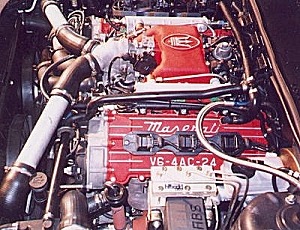 |
||
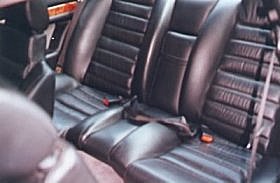 |
Ground clearance was a serious problem on the early Ghiblis with 16 inch wheels and requires sleeping policemen to be treated with respect. The move to 17 inch wheels was in part to combat this problem but the driver still has to be careful. Another reason for enlarging the wheel sizes was to allow fitment of ever-larger brakes. Each model change saw the use of different brake discs and heat was obviously a problem throughout as Maserati did not provide brake back plates to protect the discs from road grime in an attempt to aid cooling. This has the effect of causing the discs to corrode more quickly and can be a problem on cars that are driven infrequently. |
||
The standard fitment electronic shock absorbers (although they were a delete option) were, unfortunately, not particularly reliable. Problems with leaks or seized motors are common and they are very expensive to replace. |
|
| HOW TO BUY | |||
Information is power. The buyers must do their research because there is very little information available on these cars, they don't appear in the Glass Guide, for instance. The entire model history must be known before an informed purchase can be made. |
|||
| THE MARKET NOW | |||
The Ghibli was certainly a casualty of Maserati's 1998 renaissance. All official interest in the car effectively ceased at that point and those dealers that had taken cars from Maserati UK to sell discounted them heavily to clear their showrooms in anticipation of the 320OGT. Therefore, a year ago a new Ghibli GT could be bought from an authorised dealer for as little as £28,000. The result for the second-hand market was catastrophic. Owners found that the car they had bought only a year earlier had lost thousands of pounds in value almost overnight. |
|||
| BEST BUY | |||
The classic of the range in years to come will undoubtedly be the Cup. It offers not only a racing pedigree but also a fantastic driving experience for the enthusiast. It is no more expensive to maintain than any other in the range and due to its rarity will always have a market when you are selling, which you won't want to, of course, because the tactile pleasure of its dynamics makes every trip an occasion and that addiction will be hard to give up. Currently a Cup car is worth £25,000 to £28,000 depending on whether the sale is private or from a dealer. For left-hand drive cars, subtract £8,000. |
|||
| CONCLUSIONS | |||
Buying a second-hand car is usually a case of comparison, yet the Ghibli does hat fall into this category. You just have to want one. And, if you want it badly enough and are prepared to suffer its eccentricities and undoubtedly high maintenance costs, then you are hooked. If none of the above article fazes you and you just look at the photos with an evil, childlike grin on your face, then you are a potential Ghibil owner. Buy with emotion, however, and the dream could end very quickly Instead, buy with your head but on behalf of your heart. |
|||
| THE SPECIALISTS | |||
Meridien Modena (Sales, servicing and parts). Tel: 02380 283404 |
|||
The above article is only an excerpt of the original text that appeared in the November 2000 issue of Auto Italia. The magazine that contained this excellent article in full can be purchased by writing to Alison North at: |
|||
| Auto Italia Magazine Intermarque Publications Ltd Winchester Court 1 Forum Place Hatfield Hertfordshire, AL10 0RN or You can phone or fax Alison with your order on Tel: 01707 273999 or Fax: 01707 276555 | |||
| This back issue, including postage, costs only £5.25 for the UK, £6.25 for Europe and £7.25/ US $10 Worldwide. |
|||
| If your thinking of buying a Ghibli, it's money well spent! | |||
 |
|
To enter Enrico's Maserati Pages CLICK HERE! Copyright: Intermarque Publications Ltd - © 2001-2005. All rights reserved. Reproduction in whole or part, without written permission, is prohibited. Copyright: Enrico's Maserati Pages - © 2001-2005. All rights reserved. |